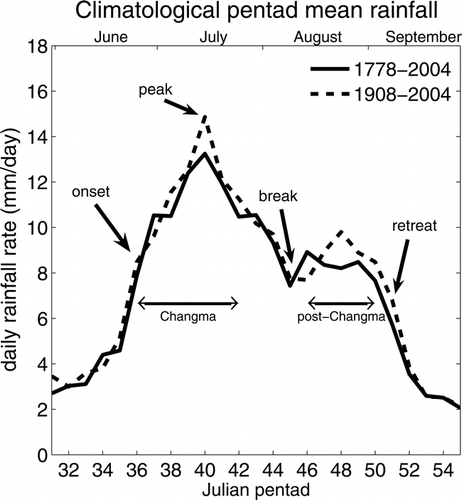To satiate my curiosity, I tried to find, via online news reports, the reported first Jang-Ma days in Korea over the past ten years. Caveat: I am not so sure about 2011’s truly-very-early date, which may only have influenced Jeju Island.
Dates of the Start of Monsoon Seasons, Jang-Ma, in Mainland Korea
2005: June 26th
2006: June 21st
2007: ?? — I could not find it in the English press
2008: June 17th
2009: June 25th
2010: June 19th
2011: June 10th — “the monsoon…arrive[d] earlier than at any time since the KMA began compiling statistics in 1973”
2012: June 30th
2013: June 17th
The average “Monsoon season onset day” in the past decade, if excluding 2011, is June 22nd; if including 2011’s, it’s June 21st. Both are earlier than the historical average of June 25th-29th. That date range is according to this, which analyzes the entire period of 1778-2004 for Seoul.

From “Variability and Singularity of Seoul, South Korea, Rainy Season (1778–2004)” [Link]
1778-2004 Average: June 25th-29th
1981-2010 Average: June 24th-25th
2005-2013 Average: June 21st-22nd
My final conclusion: The June 17th 2013 Monsoon was “early”, but not very early. More interestingly, the recent average start day of the Jang-Ma season has been getting earlier, if my attempt to analyze the data is correct. This does not point to a general “warming trend”, because, also ancedotally, I can say that winter was very, very long this year (see post-34 and post-63). Koreans themselves have been saying spring starts later and later each year recently.

Chosun: 1778-1907 / Modern: 1908-2004.
Table 1 from “Variability and Singularity of Seoul, South Korea, Rainy Season (1778–2004)” [Link]
Meteorologists believe Korea is witnessing a rainy season throughout the summer as the country’s climate turns subtropical, with global warming raising the amount of water vapor in the atmosphere. The “August rains” often cause a substantial amount of damage, since torrential downpours are focused on a small area over a short period of time. Between 1954 and 1963, only an average of 1.6 days a year saw 80 mm of rainfall a day. But that increased to 2.3 days between 1994 and 2003. The torrential downpour phenomenon is becoming a feature of our weather. Global warming increases the amount of energy in the atmosphere, leading to more frequent extreme weather conditions, such as typhoons.

Comments
Comments are closed.